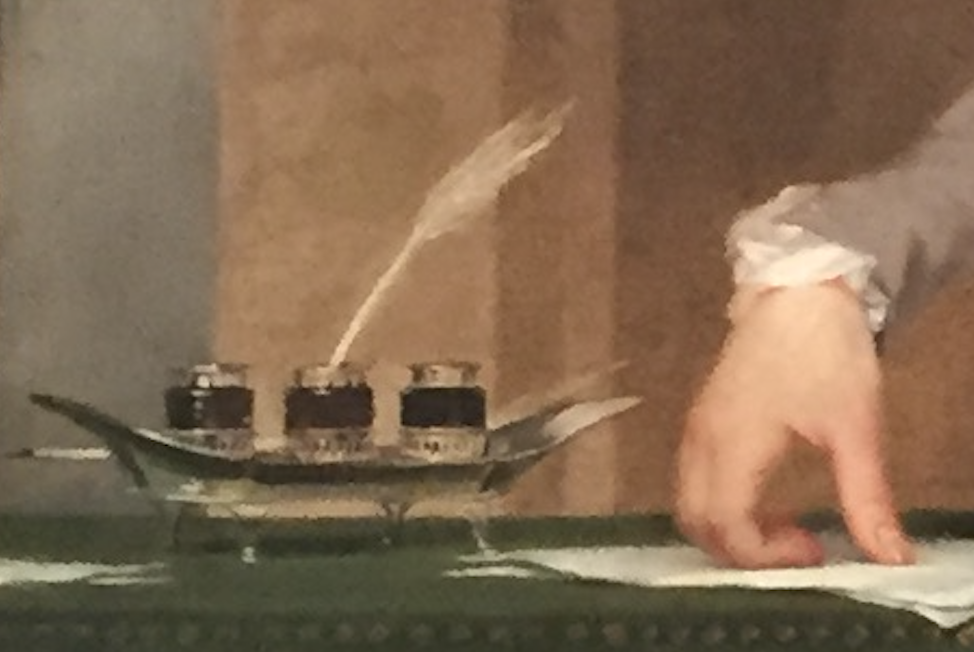Desks and their accessories have lost their importance in the last generation. While people with power may still maintain a desk largely for appearance’s sake, the traditional desktop elaborately decorated with a coordinated blotter, pens, calendars, picture frames, and other items has almost disappeared, and with it the piles of important papers to be read and letters to be signed. Now those powers are replaced by digital fies, and power is measured by constantly-updated devices, sleek and expensive. In some fields even the desk itself has disappeared.
But in the 1790s, America’s most important communications were taking place through pens, ink, and paper, and the only kind of word processing was what a writer committed to paper, word by word and one copy at a time. The greatest documents of the age were all first written by hand, as was every sermon, song, novel, legal judgement, school lesson, and love-letter. Penmanship mattered, too. In a world without email, dm’s, or tweets, the ability to write in an elegant “good hand” set an educated person apart from the less refined scrawl.
It’s no surprise, then, that a well-appointed desk mattered as well. While portable or field desks like this one were all well and good for dashing off hasty thoughts or letters while traveling, at home the Founding generation was more particular. Pens were cut from goose quills, the shape and point of the nib being a matter of personal preference. Ink could be purchased, or made at home from various recipes. Paper was still handmade in mills from rags, and most continued to be imported from Great Britain.
The soft, almost velvety surface of laid paper combined with the sharp but flexible nib of quill pens required a desktop covered in a forgiving leather or felt. Other niceties for civilized writing included a pounce pot containing ground powder, or a sander with fine sand, which would be scattered over a freshly written page to absorb excess ink and hasten the drying time. Because envelopes were not yet invented, sealing wax was essential to close a folded letter, and a personalized signet or stamp to press into the still-molten wax added a final touch.
These elements were in themselves symbols of wealth, education, and power. The elaborate silver-plated inkstand, above, further elevated both the writer’s words and the process of writing itself, especially when proudly displayed on a fine desk of mahogany or cherry. Probably made in Birmingham, England by prominent silversmith Matthew Boulton (1728-1809), this boat-shaped inkstand included a pot for ink and another that may have held water for rinsing ink from nibs, with a candle-holder and snuffer in the middle. The candle-holder also serves as a lid for the round container beneath, which may have once held sealing-wax or wafers.
The inkstand’s elegant lines would have been at home in the neoclassical furnishings popular during the Federal era of the late 18thc. It’s nearly a twin to one that appears in the portrait of Alexander Hamilton, left, painted in 1792 by John Trumbull. While Hamilton had requested to be portrayed simply as a citizen (albeit an elite one), the inkstand alludes to his prolific, important writings as well as his gentlemanly taste. lt’s also a tangible symbol of Hamilton’s heady rise from his days as an orphaned adolescent clerk, scrivening accounts for a merchant house in the West Indies, to the new country’s first Secretary of the Treasury.
The inkstand is currently on display in the "Schuyler Sisters & Their Circle" exhibition (on display through December 29, 2019 at the Albany Institute of History & Art in Albany, NY.
Above: Inkstand, probably by Matthew Boulton, c1790. Lent by N. P. Trent Antiques for the “Schuyler Sisters and Their Circle” exhibition, Albany Institute of History and Art. Photo ©2019 by Susan Holloway Scott.
Below: Alexander Hamilton by John Trumbull, 1792, Metropolitan Museum of Art. Photo ©2018 by Susan Holloway Scott.
Read more about Eliza Schuyler and Alexander Hamilton in my historical novel, I, Eliza Hamilton. My latest historical novel, The Secret Wife of Aaron Burr, is now available everywhere. Order here.



